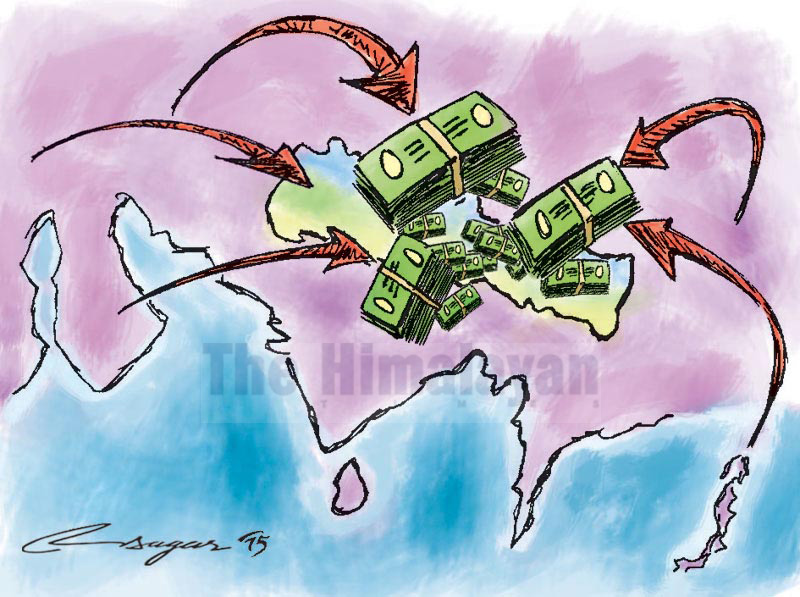Responding to COVID-19’s impact on remittances
July 3, 2020
Remittances are very crucial to many low-income and middle-income countries (LMICs). Though these financial flows somewhat demonstrated their resilience during the global financial crisis of 2008 and the Ebola epidemic of 2014, they have been under threat in recent months by the COVID-19 pandemic. This pandemic is atypical due to its worldwide impact, as workers overseas are susceptible to losing their incomes at a time when the crisis is affecting their home countries. According to the World Bank, remittances to LMICs are envisaged to plummet by about 20 per cent to $445 billion in 2020 from $554 billion in 2019.
Lockdown measures executed in the host countries have resulted in many migrants losing their jobs, consequently leading to a sharp reduction in remittance flows to the developing countries. The global nature of this crisis implies that not only will remittance income shrink in the recipient countries, but these countries will also possibly witness a cutback in aid from the donors who themselves have been adversely affected.
If the crisis protracts, 2020 will be a year after many decades when remittances will be less than FDI. It should be well understood that while attracting more FDI is governed by the policies and programmes of a recipient country, this is not true of remittances. Therefore, countries will require a more liberalised FDI regime to meet the void generated by dwindling remittances.
With regard to Nepal, in the past, remittances had played a relatively significant role in uplifting millions of people out of poverty, empowering women with a bigger role in financial decision-making, and improving the health and education of some of the poorer sections of societies. Without remittances, however, families face the grave consequences of not being able to meet the basic needs.
Further, banks in Nepal rely largely on remittance inflows as a cheap avenue of deposit funding as these flows are altruistically driven. In the new context, however, their cost of operations will surge and their ability to expand credit will significantly decrease. On top of that, the credit-constrained private sector will lose remittance funding, besides having to cope with much tighter credit terms from the banks.
Moreover, the drastic fall in remittances will lead to sharper economic downturns during the period of this pandemic. This will also pose massive economic development repercussions on the country with the possibility of a reduction in welfare of several households, who will possibly curtail their expenses, including in health and education, while pushing them back into poverty.
Nepal's economy is one of the most remittance-dependent economies in the world as these financial flows accounted for 26 per cent of GDP in 2019. Until a few months ago, they had been a large contributor to the foreign exchange reserves needed to finance imports of goods and services. They had constituted a sizeable fraction of financial inflows which supported macroeconomic stability. Because of the prevailing COVID-19 pandemic, a sharp decline in remittances will threaten macroeconomic stability and will also undermine the country’s external stability. The World Bank estimates that remittances to Nepal in 2020 could drop by 14 per cent.
In Nepal, as there will be less employment opportunities while jobseekers will be more, the policymakers will need to formulate new workforce strategies to accommodate the mammoth number of migrant labourers since reverse migration will add to the growing unemployment and exacerbate rural poverty. The country will have to learn to live, at least for some time, without a large portion of foreign exchange sent by overseas workers, as the post-COVID-19 climate will be totally different.
In further responding to the pandemic, the policymakers have to develop and implement policies and programmes that can mitigate the negative socio-economic impacts. For instance, time-bound action plans to support inclusion of returnees in existing programmes coupled with development of workable migration-specific instruments can support economic stabilisation. This will provide support in the utilisation of savings for productive purposes, responding to the needs of returnees as well as serving to stimulate local economic and labour market activity.
Similarly, information campaigns and community programmes targeted at promoting social interaction between the returnees and the broader community are needed to facilitate the social and economic reintegration of returnees into the community. Again, short-term socio-economic support programmes must be implemented to provide support to remittance-dependent families faced with an abrupt paucity of income, with the aim of meeting their basic needs together with maintaining children’s access to education and health services.
It is also crucial to monitor the changing socio-economic situation in the destination countries, particularly those that are members of the Gulf Cooperation Council, Malaysia and Republic of Korea where majority of the Nepali migrant workers are employed. This can take place through the effective engagement of the Ministry of Foreign Affairs, Nepali embassies overseas and Nepali diaspora associations and networks. The objective is to gather information about pertinent issues and concerns by involving such forums and forward them to the senior policymakers for remedies and decisions, thus developing a reporting system for potential responses to the pandemic.
Finally, owing to the high dependency of our economy on remittance flows, a credible, convincing and comprehensive study is vital for understanding more of its impact as well as other possible mitigation measures in the aftermath of the COVID-19 outbreak.
Pant writes on globalisation and trade issues






